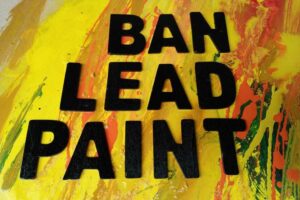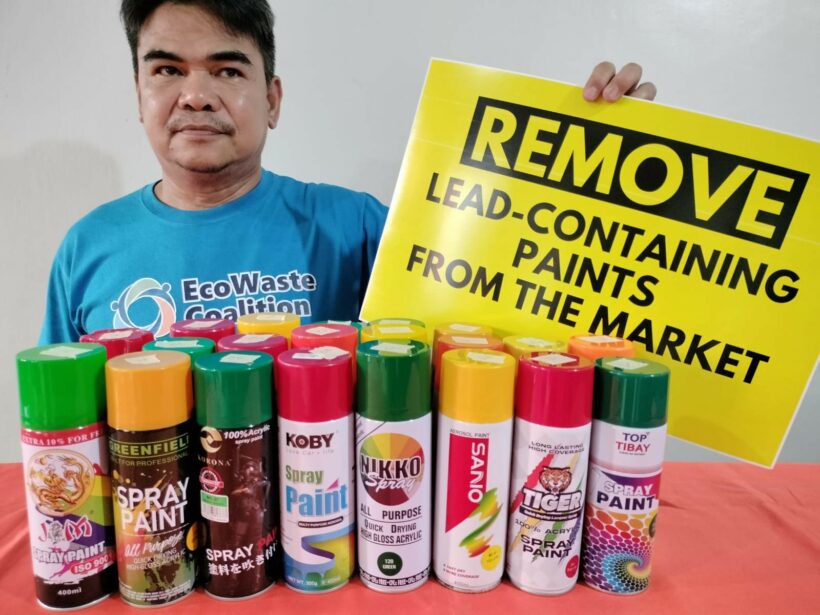11 January 2024, Quezon City. With the start of the New Year, the toxics watchdog group EcoWaste Coalition again reminded consumers to steer clear of aerosol paints containing lead, a hazardous chemical banned in the manufacture of paints and similar surface coatings to protect human health and the environment.
The reminder was prompted by the group’s discovery of 31 more spray paint products representing 12 brands, which have been verified to contain lead above the legal limit of 90 parts per million (ppm).
Before 2023 ended, the group submitted 31 bright-colored paint products to SGS, a global testing company, for lead content analysis. The products, mostly imported from China and Thailand, were obtained from online sellers and retail stores located in the cities of Baliwag, Makati, Manila, Cebu, Lapu-Lapu, Mandaue, and Davao, and the municipalities of Pateros and San Antonio (Nueva Ecija).
Based on the laboratory test results, all 31 paints contained lead over 90 ppm, the maximum limit for lead in paint products under the DENR A.O. 2013-24, or the Chemical Control Order (CCO) regulating lead and its compounds.
None of these lead-containing paints were manufactured, imported, or distributed by member companies of the Philippine Paint and Coatings Association (formerly PAPM).
Twenty-four of these paints contained high lead concentrations above 10,000 ppm. Topping the list of products with the highest lead content were Sanvo Aerosol Paint (yellow) with 118,000 ppm and Top Tibay Spray Paint (canary yellow) with 111,000 ppm.
Among the spray paint brands with lead content above 90 ppm were Chappie (orange-red), Greenfield (gold), JM (grass green, leaf green), Koby (deep red, Mars red, orange-red, Suzuki red), Korona (grass green), Nikko (apple green, grass green, green, orange, medium yellow, yellow), Parlux (canary yellow), Sanvo (orange, yellow), Tiger (grass green, bright red, lemon yellow), Top Tibay (fresh green, canary yellow, medium yellow), Yestar (art yellow), and Bad Axe (sky blue, jade green, canary yellow, deep yellow Gongcheng orange yellow, orange-yellow).
None of these paints provided lead content information and warning. In fact, the four lead-containing Korona and Tiger spray paints even carried the “No Pb” pictogram (Pb is the chemical symbol for lead from the Latin plumbum) despite having lead in the range of 171 to 67,800 ppm.
“The continued sale of non-compliant paints in online shopping sites and retail stores should prod the authorities to strengthen existing enforcement mechanisms and get these products removed from commerce without delay,” said Manny Calonzo, Campaigner, EcoWaste Coalition. “The government should also embark on new initiatives that will uphold the lead paint ban, including nominating lead chromates, the most common lead-based paint pigments, for listing under the Rotterdam Convention. We believe this will help in controlling the global trade of lead chromates used in the manufacture of paints, as well as paints containing them.”
“The availability of lead-based paints in the market despite the ban is deeply concerning as such products are a major source of lead exposure among children,” said Jeiel Guarino, International Lead Paint Campaigner, International Pollutants Elimination Network (IPEN). “Lead is considered a non-threshold toxicant — there is no known threshold for lead exposure that is deemed safe. Exposure to this potent neurotoxin can harm a child’s developing brain and nervous system, which can result in learning difficulties, reduced intelligence, low performance in school, and behavioral problems.”

The EcoWaste Coalition and IPEN are one in urging stakeholders from the government, industry, civil society, and other sectors to actively support policy measures and other initiatives that will protect vulnerable populations, particularly children, women of childbearing age, and workers, from the harmful effects of exposure to lead from lead-containing paint, dust, and soil.
The EcoWaste Coalition will notify concerned agencies about the 31 lead-containing spray paints and request necessary regulatory action to uphold the nation’s historic lead paint ban, which received the coveted Future Policy Award (special category on lead in paint) in 2021.






